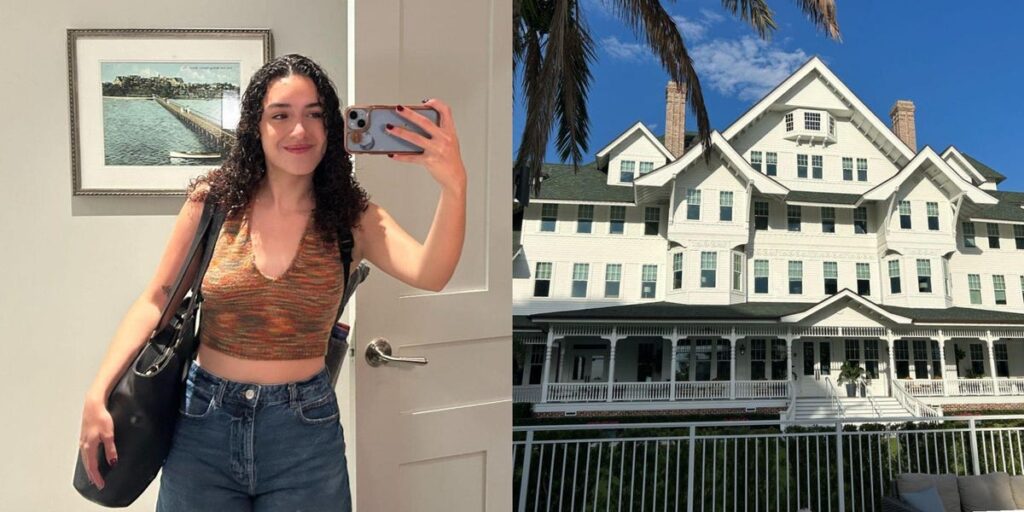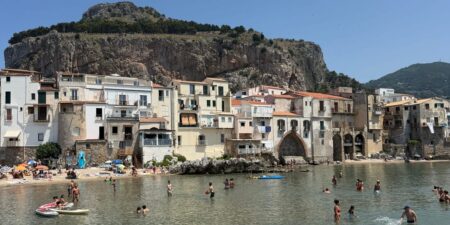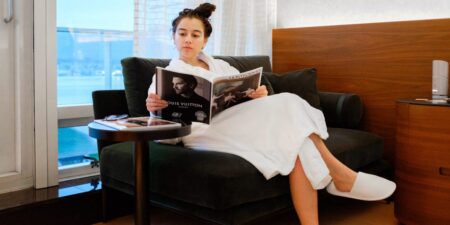X
Copy link
Impact Link
Save
Saved
Read in app
subscribers. Become an Insider
and start reading now.
Have an account? .
- The Belleview Hotel, which opened in 1897, was a retreat for America’s elite during the Gilded Age.
- Constructed by railroad magnate Henry B. Plant, it attracted visitors traveling via train.
- Only a small portion of the historic hotel remains, and it operates as a luxurious 35-room inn.
At the height of the Gilded Age, a railroad tycoon opened Florida’s Gulf Coast, then a small community, to America’s elites.
Opening its doors in 1897, the Belleview Hotel, built by railroad giant Henry B. Plant, hosted the extremely wealthy in an exclusive refuge from their hectic big cities and industry hubs.
The hotel was constructed as a way to attract visitors to the Tampa Bay area, where Plant had expanded a railroad system. Visitors to the hotel arrived directly by rail, and they could disembark the train and immediately check into the resort once nicknamed the “White Queen on the Gulf.”
The Belleview Hotel, later known as the Belleview-Biltmore, quickly became a favorite for America’s Gilded Age millionaires, hosting families like the Vanderbilts, DuPonts, and Fords and figures as prominent as US presidents.
Its original structure, which hosted 400 rooms, reached over 820,000 square feet and was once believed to be the largest wooden structure in the world.
Today, after years of development drama, only a portion of the historic hotel remains.
I traveled to Belleair — the small community near Clearwater, Florida, where the historic hotel stands — and checked into the renovated 38,000-square-foot inn.
See what it’s like to stay at the historic hotel, from receiving a glass of Champagne at check-in to enjoying a hand-delivered breakfast in the morning.
The Belleview Hotel was built in 1896 by railroad magnate Henry B. Plant and opened in 1897.
The peak of the Gilded Age brought booming developments to Florida, including Henry B. Plant’s Plant System of railroads, which connected the previously isolated Tampa Bay area to cities in the Southeast.
As a way to promote the new railroad lines to Florida’s Gulf Coast, Plant built two hotels in the Tampa Bay area hoping to attract visitors: the 1891 Tampa Bay hotel in downtown Tampa and the 1896 Belleview Hotel in Belleair, a quiet town near the coastal Clearwater, Florida.
It quickly became a beloved vacation spot for America’s elites.
Opening its doors to the public in January 1897, the Belleview Hotel was quickly nicknamed the “White Queen of the Gulf” due to its grandiose architecture.
The Queen Anne-style wooden structure reached over 820,000 square feet and was believed to be, at one point, the largest wooden structure in the world, per the National Trust for Historic Preservation.
Visitors arrived at the 400-room resort via train thanks to Plant’s railroads, which connected directly to the property.
Expanding over the following decades to include a 18-hole golf course and a country club on the property, the Belleview attracted wealthy visitors such as the Fords, the DuPonts, and the Vanderbilts and prominent figures like Thomas Edison, Babe Ruth, and US presidents Gerald Ford and Jimmy Carter, as reported by the National Trust for Historic Preservation’s Historic Hotels of America.
Today, only a small portion of the original structure remains.
By the 1980s, the hotel’s grandeur had started to decline as the challenges of maintaining its iconic wooden structure grew and competing nearby hotels began shifting tourism patterns.
Following a series of acquisitions and renovations throughout the 1990s, portions of the hotel fell into disrepair. Then, in the summer of 2004, the wooden structure sustained severe damage during the hurricane season.
By 2009, after years of talks about demolishing the “White Queen of the Gulf,” the hotel officially announced its closure. By then, the cost to renovate the hotel would have been over $200 million, requiring room rates as high as $600 nightly to balance the renovations, the Tampa Bay Times reported.
In 2015, 90% of the original structure was demolished, and the resort’s waterfront property was sold. Townhomes were built in what was once the Intracoastal view from the hotel.
After the demolition, the preserved portion of the building was rotated 90 degrees and moved nearly 400 feet east of its original foundation to make way for the townhome and condo developments built throughout Belleview’s original estate. These developments now surround the inn in a gated complex that includes the inn, country club, and residences.
Visitors to the Belleview Inn can enjoy the preserved lobby and stay in the original rooms.
In the preserved portion of the hotel, which has operated as a small inn since 2018 under new ownership, visitors can step into the past.
Checking in, I felt transported. The original wooden floors and grand staircase welcome visitors into a uniquely immersive historical experience.
The lobby showcased white paneled ceilings, dazzling glass chandeliers, and classic decor, as well as a majestic grand piano.
As I walked in, my footsteps echoed throughout the quiet lobby. At the reception desk, I rang a bell to signal to the inn’s small staff that I had arrived.
Renovated interiors and old-fashioned hospitality keep the hotel’s legacy present.
The staff is friendly and knowledgeable about the hotel’s long history, which is displayed everywhere — framed historic paintings and illustrations of the Belleview line its walls.
My room was located on the second floor, and walking up the stairs up to my room felt like stepping into one of the many artworks on display.
While the hallways have been renovated and modernized many times since the hotel’s 1897 opening, with the most recent being prior to its 2018 reopening, the interior structure of the hotel remains, with the wide walkways and central staircase reflecting the hotel’s history.
Today, the inn hosts visitors in just 35 of its original rooms.
At $260 for one night — or $230 for Florida residents, plus a $25 nightly resort fee — the standard king bedroom offers a comfortable and luxurious accommodation.
Despite booking a standard bedroom, I was given a complimentary upgrade to a junior suite, as the hotel had light occupancy during my stay. The room I was placed in costs $325 a night, or $275 for Florida residents.
I had a view of the hotel’s pool, as well as the surrounding townhomes. My room had a large sofa, a lounge and a reading chair, a full-size desk and closet, and a separate “parlor area” with a coffee machine and mini refrigerator.
The room also had two separate TVs, one facing the bed and another facing the living space.
While mostly renovated, the room’s wall details and window sashes appeared to nod to the hotel’s history. The decoration, albeit modern, paid homage to the classic elegance of its past, with dark leather chairs and shiny metal details throughout the room.
Hotel staff presented me with a glass of Champagne on my arrival.
I sipped a glass of Champagne as I walked upstairs and explored my room. The gesture made me feel like a member of an exclusive club of Gilded Age elites.
Guests have access to the hotel’s pool and outdoor areas.
From my room, I got a full view of the pool, which hotel guests can access throughout the day. The pool is overlooked by surrounding condos, offering a not-so-private experience.
While the current pool was added during the 2018 renovation, based on pre-demolition photographs, Belleview’s pools date back to 1899, when Henry B. Plant’s son, Morton Freeman Plant, who ran the hotel after his father’s death, built an Olympic-sized pool lined with Italian tiles, according to the hotel’s website.
Downstairs, guests can visit a café stocked with a wide variety of drinks and snacks.
The hotel’s café — its solution to the lack of on-site restaurant and bar — offers a variety of snacks, drinks, desserts, and Belleview Inn souvenirs.
I found the service a bit confusing, as I never saw employees near the café. Nancy Cimney, the regional director of sales and marketing for Opal Collection, which runs the inn, told Business Insider its small staff is cross-trained, and while there isn’t a member of staff solely focused on working at the café, team members are always available to help customers.
The hotel was quiet during my weeknight stay, making it feel a bit like a ghost town at times. Cimney said weeknights during the summer months tend to be some of the inn’s quieter periods, with occupancy peaking during the winter months and over spring break.
I wondered what it would’ve been like staying in the same room a hundred years prior, during the heyday of the resort.
Guests can also take advantage of an in-building gym and a small conference room.
The hotel’s small gym offered a limited selection of cardio and weight-lifting equipment to guests.
Although the hotel is no longer on the waterfront, guests have access to a private beach at a sister hotel in Clearwater.
While the Belleview Inn is now presented as a golf-forward property farther inland, guests looking to experience the white sand beaches of the Florida Gulf Coast can head over to the Sandpearl Resort, a sister hotel, and enjoy its private beach.
I took a 15-minute Uber to check out the beach and eat at the resort’s on-site restaurant. Unlike the quiet surroundings of the Belleview Inn, the Sandpearl Resort is located on a very touristy area of the Clearwater beach.
Back at the hotel, the grand piano offers guests entertainment on some nights, but not during my stay.
During select summer Fridays, the Belleview Inn hosts piano nights in its lobby, with a dedicated pianist playing for hotel guests and members of the public.
However, during my weeknight stay, the hotel remained quiet at night. Without a restaurant, bar, or spa on-site, the Belleview Inn felt more like a place to sit back, indulge in its rich history, and relax.
In lieu of entertaining areas for guests, the hotel holds a room dedicated to its history.
One of the rooms open to guests at the Belleview Inn is a history room showcasing different artifacts from the resort’s past. The moody room has dark wood and leather details and is filled with pictures, paintings, and objects transporting guests through the hotel’s history, almost serving as a museum.
The next morning, I was greeted by a breakfast basket delivered straight to my door.
After a long and restful night of sleep, a breakfast basket hand-delivered by hotel staff waited at my door.
The baskets, delivered to guests each morning, are one of the inn’s signature gestures and are included in the cost of the stay.
Inside the basket, a small breakfast waited for me.
The basket included a freshly baked croissant made in-house, a bottle of Florida orange juice, an apple, and a packet of jam and butter.
While the hotel doesn’t offer a traditional continental breakfast, the breakfast basket gave me the fuel I needed to start my day.
Eating on the wrap-around porch gave me a quiet, reflective moment to contemplate the location’s history.
While the pool offered a nice place to splash and sunbathe, the porch was where I found my spot to lounge.
Having my breakfast basket on one of the many chairs and side tables alongside the extensive porch — which extends the length of the hotel in both the front and back — gave me the opportunity to contemplate the rich history of the wooden structure.
Across the street, the Belleair Country Club welcomes members and hotel guests alike.
The exclusive country club and its 18-hole golf course — which is also the oldest golf club in Florida, dating back to the Belleview Hotel’s opening in 1897, as reported by Links Magazine — sit across the street from the historic hotel.
The golf course, which originally featured six holes and was part of the Belleview resort, was expanded under Morton F. Plant’s ownership. It was operating as the Belleview Country Club by 1909, when it was lauded as one of the top golf locations in Florida, as reported by Historic Hotels of America.
Today, guests at the Belleview Inn can enjoy the amenities at the country club, which include a restaurant, bar, golf courses, and spa.
Staying at the Belleview Inn felt like stepping into a museum, and I’d do it again.
Departing in the early morning, I left the Belleview Inn reflecting on its history, which was nearly impossible to escape as every wall — including inside my bathroom — displayed memories of the hotel’s past.
I had basked in the experience, listening to the audio tours shown in QR codes alongside custom paintings as I explored the hotel.
Even after a complicated history of renovations, relocations, and demolitions, the hotel preserves its classic, 19th-century soul.
If anything, I wish my stay would’ve lasted longer, and that I had packed an extravagant period dress, just for the thrill of it.
Read the full article here
















